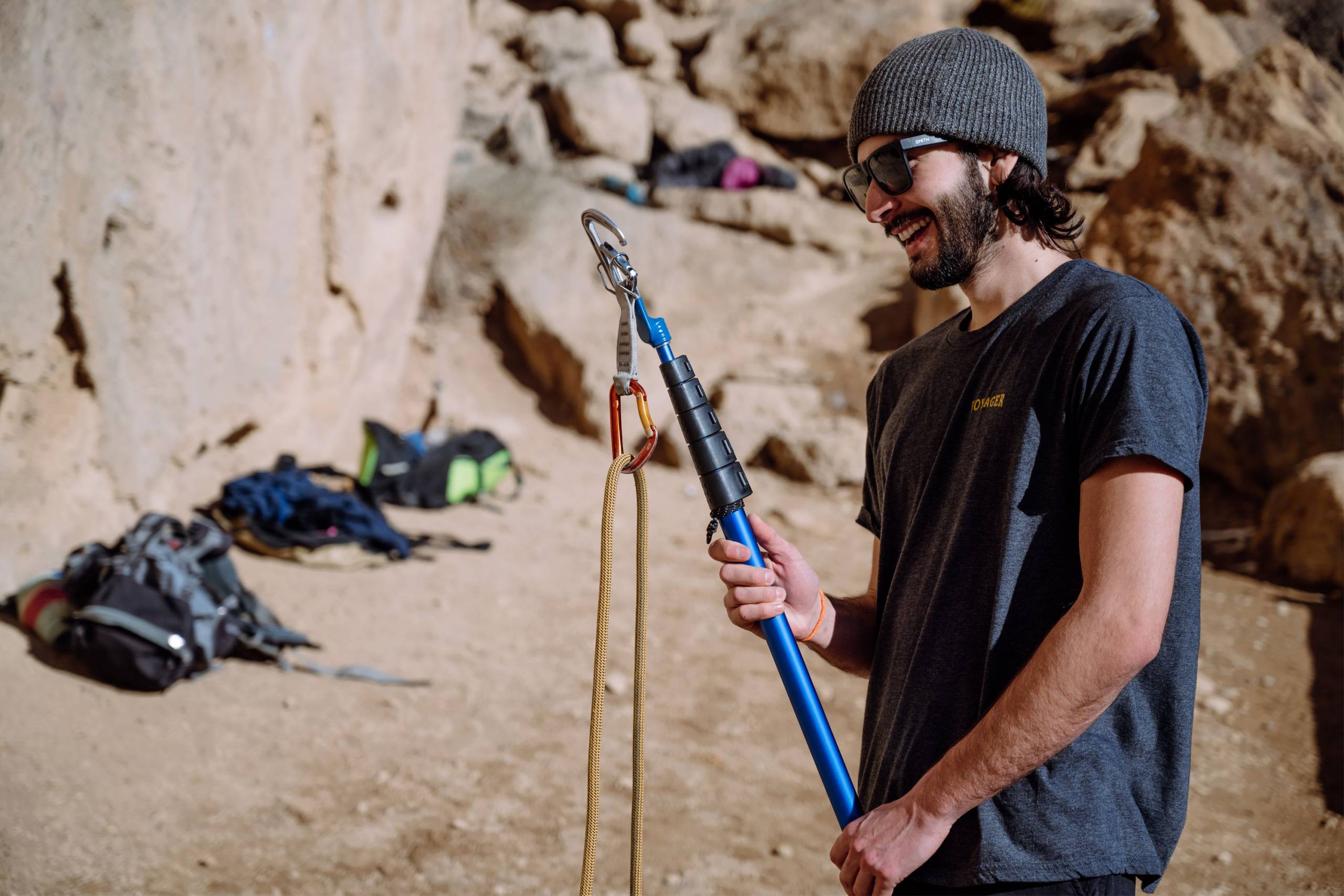A better stick clip design, simply — that’s the notion that elevated Skyhook to Kickstarter success.
There are two kinds of outdoor gear users: those who simply deal with unsatisfactory gear and those who refuse anything that falls short.
In the former camp are the people who will go on using boot laces that are 6 inches too long. Sure, it’s bothersome, but folks often won’t make the necessary change. Small inconveniences roll off of them like raindrops on a tent fly.
But in the other camp are those who can’t stand to live with ill-fitting and ill-functioning gear. When there’s a problem, it must be fixed. Small design flaws are plainly intolerable for these folks, and they won’t rest until they find a better way.
Quinn Rohlf, the creator of the latest rock climbing stick clip to enter the market, is this kind of person. Rohlf has the mind of an engineer and refuses to accept a world full of frustrating and subpar stick clips. Thus, he went to work, and the Skyhook was born.

Skyhook Stick Clip for Climbing
The idea to design the ultimate stick clip came to Rohlf during a summer spent sport climbing in Ten Sleep, Wyo.
In Ten Sleep, approaches to the crag aren’t exactly long, but they aren’t short either. And many involve scrambling up a steep hillside or maneuvering between downed trees. While rock climbing-specific extension poles do exist, many climbers continue to use bulky, industrial hardware store options that are upwards of 6 feet long and as thick as a pumped forearm.
On a steep or technical approach, wielding a cumbersome pole just seemed preposterous to Rohlf.
“I realized that, at the time, every option on the market was frustrating to use,” he said. He envisioned a stick clip that could be carried easily without sacrificing function.
As Rohlf shared his idea with other climbers, he found that many others expressed a desire for a better stick clip. After a fateful fireside brainstorming session, Rohlf soon returned home to Bend, Ore., and got to work on the new product.

Skyhook Stick Clip Design
Rohlf, who has a background in robotics and fabrication engineering, has now reached the final stages of product development. The Skyhook began shipping out to customers in May 2021.
“We didn’t do any Instagram ads or online marketing,” he said. “We fully relied on word of mouth and a tight-knit network of climbers.”
A Kickstarter campaign to fund the project reached its goal in just 4 days.
The Skyhook aims to fix the key issues that have long been associated with stick clips. First, the Skyhook is made to be stiff and not wobbly — even at full extension. All sport climbers know the hassle of reaching up to clip a bolt while the end of their stick clip waves back and forth like a withered stalk of corn. To accomplish this, Rohlf designed an extension pole with minimal joints and a wide tubing diameter.
Rohlf worked through several iterations and prototypes to identify the ideal ratio between maximum extended length and minimum collapsed length.

“There are trade-offs,” Rohlf explained. “Ultimately, we valued practicality and usability over a super long maximum length. We refused to create a wavy, noodly, frustrating pole.”
At maximum extension, the Skyhook reaches more than 10 feet long. But when collapsed, it’s compact — less than 30 inches long — and small enough to fit into most climbing haul bags and checked luggage.
Because it is so short, the Skyhook can ride in a pack on the approach and free up your hands for balance and scrambling. Should the Skyhook catch on, we may see the end of climbers wielding massive Mr. LongArm lightbulb-changing poles ala Gandalf’s wizard staff. You shall not pass!
Superclip Partnership
Per the product’s Kickstarter, the Skyhook is made of hardy aluminum and a “dirt-resistant locking mechanism.” And it says it will hold up to the standard abuse that stick clips are subjected to. Every unit comes with a clipping attachment from Superclip Rescue Tools.
The Superclip has been around for many years, and lots of climbers are already familiar with how to use it. So instead of designing his own clipping head, Rohlf partnered with Superclip.
“I’ve been using a Superclip personally since I started out climbing. When it was time to build the Skyhook, it was clear that there was no reason to create an alternative. The Superclip does everything well,” Rohlf said. If it ain’t broke, don’t fix it.
The Skyhook is also compatible with climbing brushes, so it’s useful for scrubbing holds on your home wall too. Once the first run of Skyhooks has been sent out to the initial group of Kickstarter backers, Rohlf aims to begin selling the product online and in various climbing gear shops.

Skyhook: First Mountain Drifter Equipment Product
While the Skyhook is Rohlf’s first product to hit the climbing gear market, it probably won’t be the last. For years, Rohlf has flirted with the idea of starting a brand called Mountain Drifter Equipment that focuses on “targeted and really polished climbing products.”
Rohlf has noticed that many products try to do too much to have a wide appeal and end up falling short in their actual functionality.
“There is a sliding scale of how much annoyance people are willing to tolerate with their gear,” he said. “As the industry moves forward and everything gets a little more polished and refined, people are going to expect a higher standard of product development in the climbing industry.”
The Skyhook marks the official beginning of Mountain Drifter Equipment — and hopefully the long-overdue end of wobbly stick clips. Purchase yours today.
Stick clips are simple tools that help climbers increase safety at the crag. For more information about stick clips, check out this video from AMGA guide Dale Remsberg:
Learn More at Kickstarter








